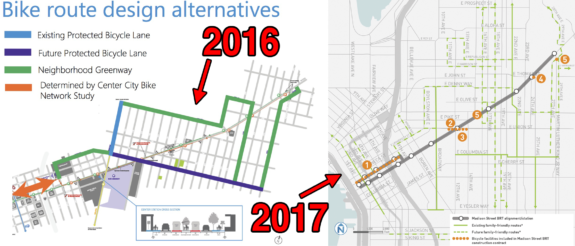
The Madison BRT project has dropped its goal of designing a so-called “parallel” bike route to accompany its $120 million plans for a faster and more reliable bus line from the waterfront to MLK Way.
But just as concerning, the few short, disconnected sections of bike facilities that are planned mostly fail to meet standards that would make them inviting for people of all ages and abilities to use.
You can learn more about the plans and provide feedback at a Wednesday open house or through an online open house. From the project info page:
Wednesday, March 15
5:30 – 7:30 PM
First African Methodist Episcopal Church
1522 14th AveONLINE
MARCH 8-22
Give feedback online!
MadisonStreetBRT.participate.online
Spring Street door zone bike lane, missing westbound lane
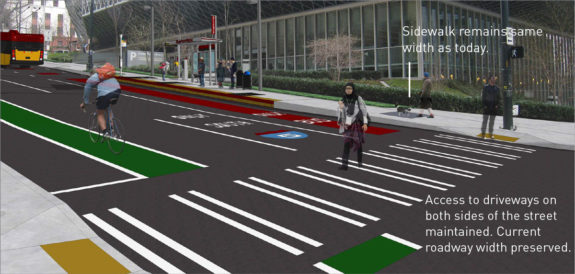
The plans for Spring Street are better than they were a few months ago, but that was a pretty low bar. In August, the project team presented plans (PDF) that would build a one-way protected bike lane eastbound on Spring from 2nd to 4th Avenues that then turned into sharrows (!) for the busy uphill stretch crossing I-5.
The latest design swaps out the sharrows for painted bike lanes, which is an improvement over the dismal August design. But the lanes are as skinny as possible and either located squarely in the door zone of parked cars or are unprotected from incursions by stopped cars or delivery trucks. There are also no plans for separating people biking from people making turns at intersections, a major cause of injury and death for people biking:
The official excuse for not including bike lanes all the way across I-5 — this is one of the very few bike route opportunities for crossing the freeway between downtown and First Hill — is that “there is not enough right-of-way.” But, of course, it’s not a matter of right-of-way, it’s a matter of priorities. The street is the same width east of 4th as it is west of 4th, there are just other uses that planners care about more.
A quality bike route along this stretch of Spring is within reach, but only if the city makes it a priority. If they don’t then the bike lane is doomed to be uncomfortable and potentially dangerous, which in turn will lead to low use. If people can’t depend on these bike routes to be safe and clear, then they can’t depend on biking as a mode of transportation.
The eastbound Spring Street bike lane has some issues, but at least it exists. The latest designs have no westbound bike lane between First Hill and downtown. The 2016 map of proposed bike routes clearly shows an arrow pointing in both directions, so the removal of a westbound bike lane is a major cut.
As with any other mode of transportation, people need to bike in both directions. Building small, disconnected pieces of the bike network is going to get middling results at a time when the city is growing and we need serious results. That’s the eventual plan, according to SDOT.
“The center city bike network is currently under study,” said SDOT staff via email. “We are holding stakeholder meetings and community briefings to prioritize the locations and types of facilities for the Center City. Our vision for the center city bike network includes east-west connections between downtown and First Hill, Capitol Hill, and the Central District.”
But this Madison project is happening now, investing $120 million in this particular corridor. There is not going to be a better time to build this connection.
SDOT’s Madison BRT team has been studying the corridor extensively at far closer detail than the Center City Bike Network or One Center City plans could, and bike connections here have been part of this project’s extensive public outreach all along. Booting one half of the bike lanes onto a separate public process is an insult to the many people who have been engaged with Madison BRT for two years now, volunteering their time to go to project meetings and provide public comment consistently noting the need for this bike connection.
People need a safe and comfortable way to bike between downtown and First Hill. This high-budget project all but promised to help make that happen. SDOT needs to stop making excuses and deliver a bike route people can use in both directions.
Options for Spring Street
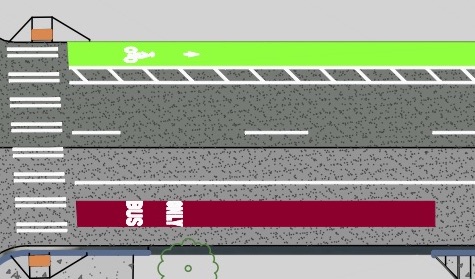
One option to make the downtown–First Hill connection would be to design the Spring Street section east of 4th like the existing plans west of 4th. Move the bike lane to the curb for the whole length between 1st and 9th Avenues, add a layer of protection (curb, paint and plastic posts, flower planters, something), and make sure intersections protect people biking from people in cars turning. A westbound lane would then need to be planned, likely on Seneca Street (connecting directly to University Street Station, which is a nice plus).
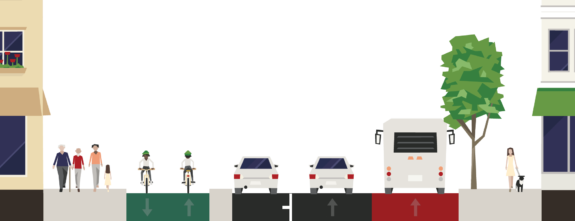
Another option would be to prioritize safety, business access, public space and loading/valet zones. If there were only one general purpose lane, there would be ample space for a high-quality bike lane (perhaps two-way), loading/valet zones, on-street parking, parklets or whatever else the city can think to add. The bike lane could be raised to sidewalk level at hotel valet stops and other loading zones, making it easy and accessible for guests and deliveries. We already have an example of this on 2nd Ave that works fairly well.
Yet another option would be a two-way bike lane on Seneca instead of Spring, but I am hesitant to even suggest it for fear that the Madison BRT team would use it as a convenient excuse to cut its funding by declaring it “outside the scope” of their project. Because that’s exactly what has happened to nearly all the other bike elements in the plan.
University Street and Denny Way Greenways
The Madison BRT project will fund “early design of the complementary greenway network going east-west from First Hill to Madison Valley,” according to SDOT. Earlier designs suggested this would consist of a neighborhood greenway on University Street from 9th Ave to Union, a neighborhood greenway on Denny Way from Broadway to the existing greenway on 22nd Ave, and a new greenway on 24th that would cross Madison and connect to bike lanes on Union Street.
There is no parallel route to Madison east of Broadway because the street cuts across the grid. But neighborhood safe streets advocates were excited by the possibility of getting these neighborhood greenway and bike lane projects moving as part of this process. They aren’t as direct as bike lanes on Madison, but they are still good connections on their own.
But as you will see, both the 24th Ave crossing and the Union Street bike lanes have been cut.
For the segments of bike lanes and neighborhood greenways that haven’t been cut (yet), there is much more this project could do to make sure they connect to the project area on Madison. For example, how will the new bike lanes to First Hill connect along 9th Ave for the two blocks to University? How will the University Street Greenway connect to the Broadway Bikeway and the redesigned 12th/Union/Madison intersection?
Those kinds of connections should be within this project scope.
More biking and walking connections needed at “The Bottleneck”
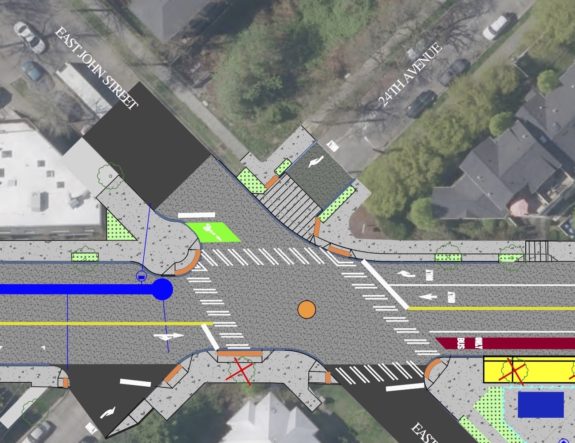 The BottleNeck Lounge is a fantastic watering hole named after the ridiculous intersection of Madison/John/24th nearby (or so I’ve always assumed). The Madison BRT project has the chance to finally make that intersection work better, especially for people biking and walking.
The BottleNeck Lounge is a fantastic watering hole named after the ridiculous intersection of Madison/John/24th nearby (or so I’ve always assumed). The Madison BRT project has the chance to finally make that intersection work better, especially for people biking and walking.
Today, it is truly awful to navigate by any mode. But if you have any kind of mobility challenge, it’s nearly impossible. Curb cuts are mostly missing, crosswalks are confusing and steep grades make all this harder to deal with.
An already low-traffic street, 24th Ave was, at least until recently, proposed as a neighborhood greenway route. Whether it’s a useful greenway for the citywide bike network is maybe up for debate, but the neighborhood desire to safely and easily cross Madison and John on foot and bike is very clear.
Current plans do include some widened sidewalks and better curb cuts, which is great. But people biking on 24th will be routed across two crosswalks and onto the sidewalk for a stretch rather than being able to cross directly. Routing people onto the sidewalk is not best practices, and a project of this scope and budget should be able to do better.
The design seems so close to making this direct connection, but right now it has stopped just short of making it work.
“To provide the required space for those biking and walking to cross this large intersection directly, the stop lines in both directions would have to move back significantly and would hinder the overall safety and efficiency of the intersection,” said SDOT via email. In other words, creating a clear and usable bike crossing isn’t a priority, so they cut it.
Union Street has been dropped entirely
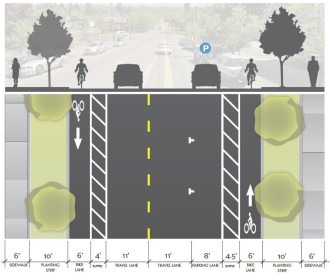
This brings us to the most disappointing part of this project update: Protected bike lanes on Union Street have been dropped entirely. I don’t mean they have just been dropped from the funding — which is disappointing enough — they have been completely removed from even the pool of projects that could get added if the city finds extra grant funding.
Union Street bike lanes were the most exciting part of this project, so this is a devastating cut. Before the Move Seattle levy vote, the city even had competing design concepts for Union, and the team asked people for feedback on their preferred option. The message was that mutimodal transportation projects would be truly multimodal under the Move Seattle. So much for that.
“Through the planning and outreach process for Union St PBLs, we heard community concerns about pedestrian safety at crossings, parking removal for businesses and residents, the importance of maintaining transit service and stops for the Route 2, which would require bus islands to accommodate PBLs, and a strong interest in undertaking a holistic review of transportation needs along the Union St corridor,” said SDOT staff in a email.
Complete streets and well-designed bike lanes improve safety for people walking, and SDOT damn well knows this. They also know how to build bus islands. These are terrible excuses. If this project wants to fund that “holistic review,” then that would at least be something. Instead, the team decided to just cut the biggest piece of bike infrastructure associated with their project even though this cut makes their stated goal of creating a “parallel” bike route impossible.
12th/Madison/Union
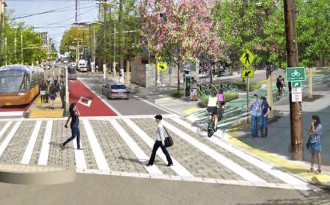
Perhaps the trickiest part of this entire route is the mess where 12th Ave, Madison and Union all converge. It’s also the spot where this project can make the biggest positive impact.
Today, it’s a mess for everyone. There’s no clear path for someone on a bike to access the Union Street bike lanes, bike lanes on 12th Ave disappear just before reaching this stressful spot (where they are needed most), and people in cars trying to make left turns have a horrible time resulting in many collisions and near misses.
The latest design has some good ideas, including banning many left turns, extending sidewalks and making Union between 11th and 12th bus and bike only.
A previous design for this intersection even became something of a poster child for the Move Seattle levy vote. It wasn’t perfect, but it included some separated spaces for people biking and people walking, and it communicated that the city can design its streets to accommodate all modes.
Well forget that. The project team has gotten rid of the separated bike connections. Under the new design, bike lanes will simply end before the intersection, dumping everyone biking onto busy sidewalks where they can try to navigate through crowds of people walking.
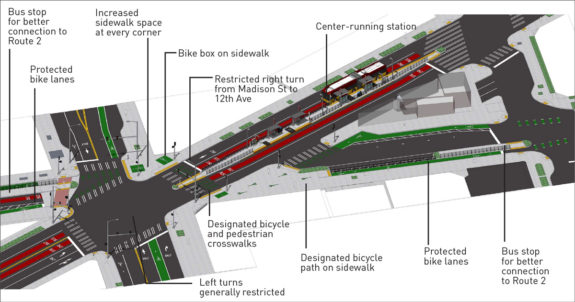 The 12th Ave bike lanes will not be protected, and there’s no clear way for people using those lanes will make left turns onto Union (especially if the sidewalks are crowded or they are riding increasingly-popular big family bikes that can’t be turned on a dime).
The 12th Ave bike lanes will not be protected, and there’s no clear way for people using those lanes will make left turns onto Union (especially if the sidewalks are crowded or they are riding increasingly-popular big family bikes that can’t be turned on a dime).
People biking on Union will have to cross in two stages, one of which involves weaving through people on the sidewalk in front of Mighty O. This might not seem like a big deal if there are only one or two people biking through at a time, but what happens when this becomes a more popular bike route as called for in the city’s Bicycle Master Plan?
Designing this intersection is difficult, I know, but the latest concept is the traffic engineering equivalent of giving up. What they really want is for people on bikes to disappear 100 feet before the intersection and magically reappear on the other side, but that isn’t going to happen. Painting some green squares on the sidewalk is not a solution.
The latest design would be better than today, but that is a very low bar. This design is not built to handle much growth in biking and walking numbers, which is all but inevitable given all the development in the area, increased use of this bus stop and city plans to increase biking.
If this were a low-budget safety project, I could see this being a good design compromise. But this is the centerpiece intersection for a $120 million project. The design needs to fix this intersection once and for all. It’s not there yet.
A disappointing vision
Thanks for reading this long and mostly negative post. I really wanted to write a happy post because I am very excited about bus rapid transit on Madison. When this project kicked off on 2015, I wanted to believe SDOT was serious when they talked about this project as a multimodal remake of the Madison corridor that would “advance the design of one east – west bicycle facility that generally connects the same neighborhoods as the Madison Street corridor” and would “provide a better bike connection to the Madison corridor, while offering comfortable connections along the corridor for people of all ages and abilities” as the initial outreach materials said. Because of that, I was a major supporter of this project.
But SDOT has failed to back up those words with design and funding, and the agency deceived safe streets supporters in the process.
I had so much hope for this project when it started that it’s just really devastating to see bike safety and connectivity discarded at every possible step. Seattle leaders give so much lip service to biking and multimodal transportation, but here they have $120 million to work with and they still cut every bike element that poses even the slightest challenge.
Bike safety and access is this project’s lowest priority. They are willing to squeeze little pieces of bike lane in where it’s easy, but that’s it.
And neighbors now know they can’t trust project planners when they promise “parallel” bike routes to so-called multimodal projects. Those parallel routes will just be cut out later in the process. I hope Delridge neighbors are paying attention, because you’re next.
The cynic in me says that Move Seattle passed, so city leaders don’t need to pretend to care about building a bike network anymore. It’s the same thing that happened to the downtown bike plan. Before the vote (which engaged bike advocates worked very hard to help pass), plans were glorious. After the vote, everything except the easiest, tiniest things got cut.
This vision will never create a connected bike network that people of all ages and abilities can use to get around town. But engaged neighbors who believe in that vision aren’t going to give up or go away. The city is prepared to make its residents fight tooth and nail for every inch of that safe bike network. And people will.
Here are the latest block-by-block designs for the Madison BRT project:

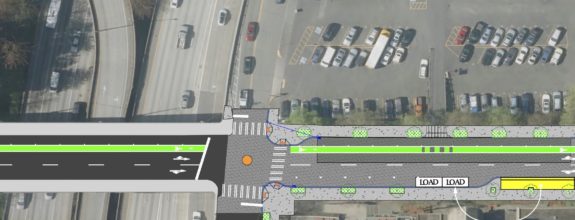
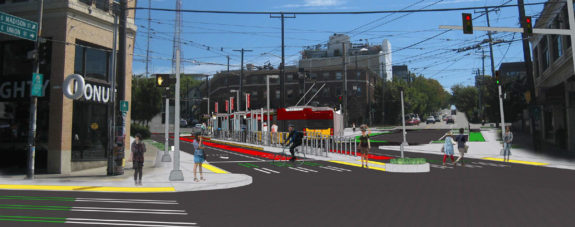
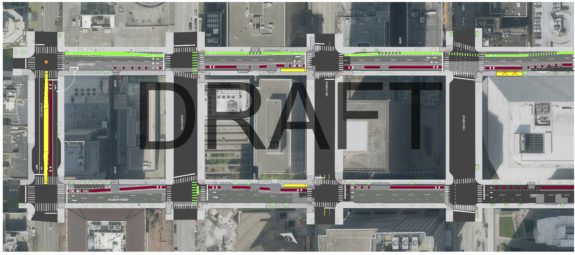
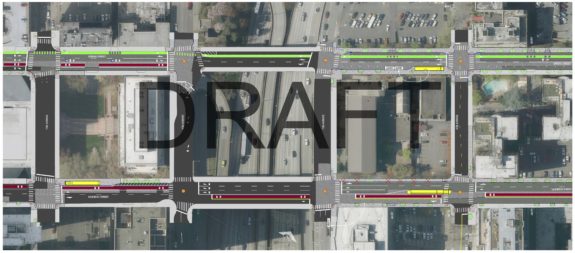
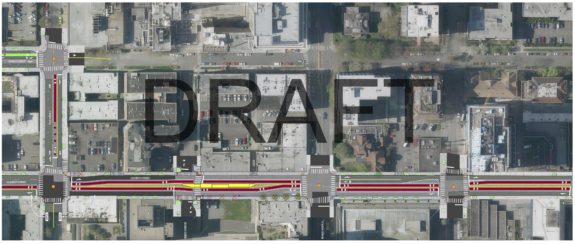

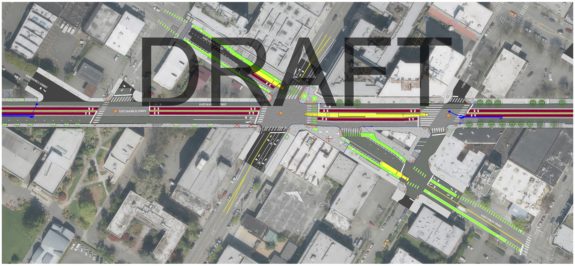




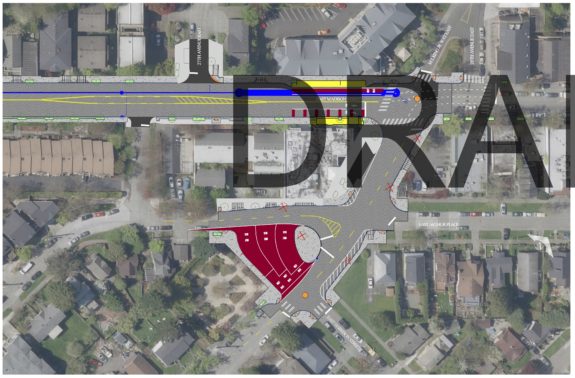







Comments
24 responses to “Madison BRT project cuts nearly all of its bike route plans”
East Union Square where E Madison, E Union and 12th Avenue intersect is a terrible intersection. People love to speed on E Madison and when the light changes you will see three or four cars run through a red light. Vehicles are traveling too fast so that they cannot stop for a signal.
I know I should not but I take the south side sidewalk to go up E Union for a bit since I’m afraid that some car turning right on E Union is going to clip me.
News flash, cyclists get shafted again. Sorry, but the bike community around here has zero political acumen, and our prosperous Mayor and his henchmen at City Hall know it and know they can keep pulling this crap without repercussions. Being right and being persuasive are two different things, and the Seattle bike lobby needs to wake the fuck up and start learning how to actually get its point across and get stuff done. Or, go back to sleep and just get comfortable with Seattle streets the way they are now.
Seattle bike community always rally voters to approve big tax hikes when the intent for better bike infrastructure is used as bait, then to find out they where used just to get votes to appease sdot and other agendas. Maybe the bike community could rally voters to change the mayor and get someone who is a mover and shaker for the bike community. There are a lot of angry voters wondering how all the bonds and such are getting passed and where the money is really going.
We had a pro bike mayor but he got voted out.
Total non-sequitor, but I’m in Amsterdam right now (not going to wait 20 more years for SDOT to do its job).
The company I interviewed with yesterday mentioned having a huge spike in US job applicants after Donald Trump’s election.
Hmmm yeah not sure if Holland would be my first choice at the moment. Are you sure you will be able to stay there if Wilders is elected?
Wilders was not a significant winner in the elections, so non-issue:
https://www.washingtonpost.com/world/dutch-vote-in-an-immigration-focused-election-with-consequences-for-all-europe/2017/03/15/f748a84e-08e1-11e7-bd19-fd3afa0f7e2a_story.html
Instead, the most progressive – and also pro-bike – parties (D66 and GroenLinks) did quite well.
I’m far more concerned with issues like the lack of specificity around the lack of an action plan and execution timeline for removing scooters from bikelanes in Amsterdam. They violate nearly every principle of sustainable safety, and cause an order of magnitude more serious injuries/fatals than other road users — not to mention the horrible air quality impact.
Thanks for letting us know how you feel Tom! Great article. My thinking has been that we need to do an inventory of the bike lanes that Seattle already has. Many of the bike lanes were quickly painted on streets that already had extra large travel lanes and they offer little if any protection for bikes. I think in many cases an extra large lane without an additional bike lane is actually better than dividing up that same space because the extra paint on the road encourages bikes to ride in the door zone or angers some drivers who don’t understand why I am riding outside of the bike lane, but I digress. Union street already has a bike lane so it’s easy for SDOT to cancel the upgrade, but the existing bike lane on Union sucks so bad it might as well not be there. In the CD almost all of the bike lanes are the same way, Jackson, Yesler, Cherry, MLK, all or mostly really sucky and unsafe. I want to put pressure on the city to not count bike lanes that don’t meet minimum standards, I think only after all these existing lanes are removed from the official map and metrics that SDOT will see how much really can be done to make biking safer
Sharrows are useless. If you ask most vehicle drivers what they mean they won’t have a clue.
Thanks Tom. Delridge neighbors are paying attention. Unfortunately, bike lanes are almost entirely absent from both options in the RapidRide H plan. The better of the two plans includes only a one-way (!) bike lane for a portion of the route. Maps show the existing Delridge-Highland park greenway as a parallel route, but it’s separated from Delridge itself by large hills and doesn’t serve destinations on Delridge.
Please, whether or not you currently use Delridge, go take their online survey at https://rapidridehline.participate.online/. It’s only open for two weeks. Question 19 asks for general feedback. Let them know that Delridge needs two-way protected bike lanes along its entire length, as specified in the Bicycle Master Plan (http://www.seattle.gov/transportation/docs/bmp/apr14/SW_Sector.pdf).
[…] the deletion of most of the bike projects is quite disappointing. I wish that a more radical concept for 12th had been presented, to […]
Thanks Tom, I share your disappointment. One more intersection that you didn’t mention and deserves attention is the very end of the line where they’ve placed the bus layover. The layover location makes a lot of sense. However, Harrison east of MLK is a great bike street, and Arthur place west of MLK provides an excellent, lower grade to get to 27th and on to union. I’m not sure if these are official greenways but it doesn’t matter, because bikers use them as such. When the PCC opens in Madison Valley, this will become even more heavily used by bikes, along with Arthur east of MLK.
People will cross MLK on bike at this intersection whether you want them to or not. The way it is currently laid out, people bikes crossing MLK will go through the red layover area (between buses or through unoccupied spaces) both ways. Not the worst thing in the world, but it seems something could be done to make this crossing safer besides the one crosswalk on the south side of the intersection. Seems it was never even on SDOT’s radar even though it is clearly shown as a route in the 2015 image.
That intersection is part of the Lake Washington Loop. I guess not technically a neighborhood greenway but it is a city designated bike route.
I sometimes use the planned red bus layover section heading east crossing Madison by turning right on E Arthur Place then turning left onto E Harrison and the crossing MLK when traffic has cleared rather than try to make a left off of MLK onto E Harrison. It depends on the traffic. The other option is to cross Madison at City People’s but as Sean notes that’s probably not going to be an attractive alternative soon.
Heading west there are currently two lanes for cars to queue up in at the intersection with Madison. It looks like this will go down to one lane which will make it a lot harder to get through this intersection on a bike. Most cars turn left or right on Madison here. Some lights only one left turning car will get through per cycle. Not a problem for bikes currently because you can take the right lane to zip right through to 28th and continue on your way.
Also, what is the deal with eastbound Pike Street crossing over Madison near 14th? Looks like they are building some sort of stormwater detention/green space and eliminating the crossing heading toward T.T. minor on Pike. This is a heavily used uphill route that appears to be gone (for cars and bikes).
The amount of parking on the block of Union between 13th and 12th points to the problem. If there’s no car access to that block at all, this is easy: bikes go through directly, curving around the western edge of the bus stop. This would require a mostly-dedicated signal phase (a few crosswalks could get “walk” signals also), just like straight-through traffic on Madison and 12th get.
But all these businesses want to have their parking on the block, and the #2 bus needs to go through heading away from the intersection. So… maybe this block should work like the block of Union between 12th and 11th: one-way for cars/buses heading away from 12th. All westbound cars and buses would have to turn across the bike lane at 13th instead of merely most of them. It’s not totally clear where the street parking and loading should go relative to the bike lanes, though. Any arrangement is going to be full of conflicts and confused drivers (as it is between 11th and 12th).
If you are not aware, the block between 12th Avenue and 13th Avenue where the old medical supplies and later Seattle Academy building (was) the building that was on the spot of the med supplies/SA building has been razed. A new multi-story SA building is to be built there. I don’t know how long it will take to build but it’s probably going to be at least a year or two.
Interesting. Today Seattle Academy has an off-street lot, and maybe the new building will, too? Maybe it will be underground? The building on the south side of Union between 11th and 12th has an underground parking entrance, and eastbound vehicle access a short distance into the block is allowed basically just for loading and garage access to that building; any vehicle using the on-street loading then has to turn around to get out. Maybe it makes sense to do the same thing westbound for an SA lot/garage/drop-off area. The street is wide enough for that, it’s just a matter of conflicts and confusion… if it’s a popular/congested pick-up/drop-off location, might be better to have a one-way motor-vehicle flow to limit the variety of conflicts…
Well, it’s only rubble there so I can’t see the “land use” permit sign, but I think there is supposed to be limited U/G parking.
SDOT has long since stopped being a partner for cyclists. On project after project, they just don’t seem to even consider the needs of cyclists.
See: Madison, Union, 2nd Ave south of south of Yesler, Rainier Ave S Phase 2, Lander St Overpass, etc. Not all of these projects require expensive solutions, but nothing is cheaper than ignoring the problem.
When I go to local project meetings and talk to SDOT bureaucrats and, they pretend to listen… but I sense them thinking “Silly citizen, you couldn’t possibly understand the complexities of my job. Your idea would never work.”
#1 bike city, my ass.
Would you kindly call a sit-in at City Hall for the better plan? Perhaps a multi-day sit in, so people can come and go? I think there are enough angry people to pull that off.
The mayor and his band of SDOT geniuses need to ride on the streets they design at rush hour, without a police escort, at least once. 90 percent of what they build is useless garbage.
I wonder if hope for eventually building a complete bike network through “Complete Streets” tack-ons to non-bike-focused projects is dead, or at least paused. Today’s expectations for bike facility quality make serious demands on street space and intersection design. We don’t yet have drop-in designs, and maybe not even a well developed “pattern language” (*) for our lane and intersection challenges (especially downhill!), and of course we’re still expected to balance demands for motor vehicle access and sometimes motor vehicle capacity. We’ve either got to get bike-specific designs going or wait for better recipes to develop.
(*) For people that have read Christopher Alexander, late last year when an SDOT staffer met a bunch of people at 75th/Roosevelt in the pouring rain to talk about that project that meeting reminded me of methods he suggested in The Timeless Way of Building: a meeting between the architect/expert/designer and people that will use the new thing, right on the site, observing the space, talking about the current thing and how it works for them or not, envisioning the new thing and how it could work for them or not. With bigger projects like Madison that a ton of people care about it would be pretty tough to hold an open-house right on the site. But having selected small groups of various stakeholders meet on the site to envision and talk through possible designs might help.
[…] Seattle Bike Blog joins the STB in asking, hey, what happened to the bike infrastructure? The official excuse for not including bike lanes all the way across I-5 — this is one of the […]
[…] for service in late 2019, according to a City timeline. The recent proposal has sparked concern amongst advocates for all-ages and abilities bike facilities due to the proposal scaling back of bike […]